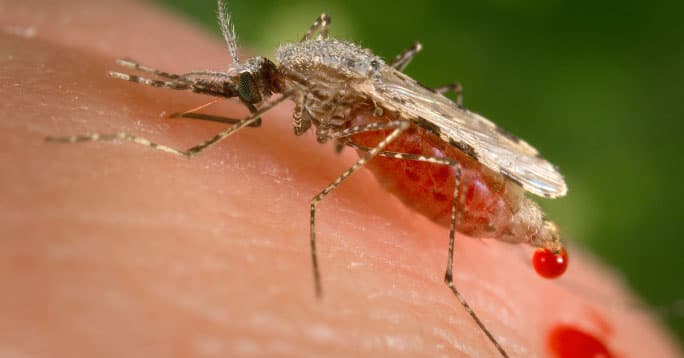DNA fingerprinting reveals how malaria hides from the immune system

A study involving more than 600 children living in a small village in southeast Gabon, near the border with the Republic of Congo, found that each infected child in one African village had a different strain of the malaria parasite and a distinctly different set of the up to 60 genes that the human immune system focuses on to detect and control this infection.
The findings help explain why people can't develop immunity to malaria and indicate that control programs should now focus on looking at the impact not just on the number of infections but the structure of diverse strains of the parasite.
Researchers from the University of Melbourne, the University of Chicago and the University of Amsterdam, working with scientists from the US, Europe and Australia, published their findings May 1 in the Proceedings of the National Academy of Sciences.
"The study began with collection of blood from 641 children, aged 1 to 12 years, living in the small village of Bakoumba, Gabon. Children in the area are frequently exposed to malaria, receiving about 100 bites from infected mosquitos each year," said study author Karen Day, Professor of Population Science and Dean of Science, University of Melbourne.
"We produced a genetic fingerprint of malaria parasites from small amounts of blood based on what are called var or variant antigen genes. These genes encode proteins that coat the surface of the red blood cells when infected by a parasite, and are important because they allow the parasite to disguise itself from the human immune system," added Prof. Day.
The malaria parasite is a single-celled microorganism (known as a Plasmodium) that infects red blood cells and is transferred from human to human via mosquitoes. Every parasite has approximately 60 of these var genes and can switch between them.

"Looking down the microscope you would think all of the infections look the same, but when we did the genetic fingerprinting with this variant antigen gene system, we could see that every child had a different parasite fingerprint, and importantly, each fingerprint was highly unrelated to all other fingerprints."
"Our results show that the parasite has evolved this enormous diversity with limited overlap between the sets of var genes. This structure allows each parasite to look different to the immune system, and provides the possibility for the malaria parasite to keep re-infecting the same people because it exists as different "strains" that can persist for many months.
Computer analyses of the variation in these sets of genes and how they might respond to control efforts with anti-malarial drugs showed that these patterns were not random. The extremely high level of diversity helps explain how the parasite evades its host's immune system.
The non-random pattern has "implications for the success of malaria-control programs," the authors note. It supports the notion that a large number of strains of the disease, each characterized by a significantly different combination of surface-coat proteins, could result in many children remaining infected even after aggressive efforts to intervene, such as mass drug administration.
"If strain theory is correct," said study author Mercedes Pascual, PhD, professor of ecology and evolution at the University of Chicago, "we would want to rethink how we approach treatment for malaria in regions such as Gabon, where multiple highly diverse strains are the rule. Also, we would need to rethink how we model malaria transmission, rather than relying on existing mathematical models designed for a much less diverse parasite population."
"There are tens of thousands of different var gene types," Pascual said. "Some are conserved and others are highly variable." Are parasites basically random combinations, a random mixture of all this variation, or are they instead different combinations with a special structure?
When Yael Artzy-Randrup from the University of Amsterdam, Pascual, and colleagues analyzed gene sequences of multiple parasites they found a structure of minimal overlap, far less than expected.
"They form niches," Pascual said. "They diversify. They try not to compete with each other, to distance themselves from each other. This opens the way to a better understanding of the parasites' success, a clue to help us disrupt its persistence," she said. "But it can be difficult to intervene in a system with such a diverse ensemble of strains."

The researchers are now var code fingerprinting and modelling malaria strains in larger human populations through time. Dr Kathryn Tiedje, a researcher in Professor Day's team at the University of Melbourne and one of the study authors, is currently looking at how control methods might impact the diversity of malaria.
"Will reducing the prevalence of malaria in any way reshape the var gene diversity," she asked, "and can interventions also reduce the number of malaria strains in the population?"
"Ultimately, the question we all want to answer is, how can we defeat humanity's most unrelenting enemy?"
The National Institutes of Health, including the Fogarty International Center and the National Institute of Allergy and Infectious Diseases, funded this study. Additional authors were Virginie Rougeron, Donald Chen and Thomas S. Rask from the University of Melbourne, Australia; Mary M. Rorick, from the University of Michigan; and Florence Migot-Nabiasi, Philippe Deloroni, and Adrian J. F. Luty from Institut de Recherche pour le Développement, Infections Tropicales, Paris, France.
Sign Up for Our Research & Science Newsletter
Subscribe to Science Life, our research and science e-newsletter. Each issue features articles on trending research topics and insight from UChicago Medicine scientists.
Subscribe Now
